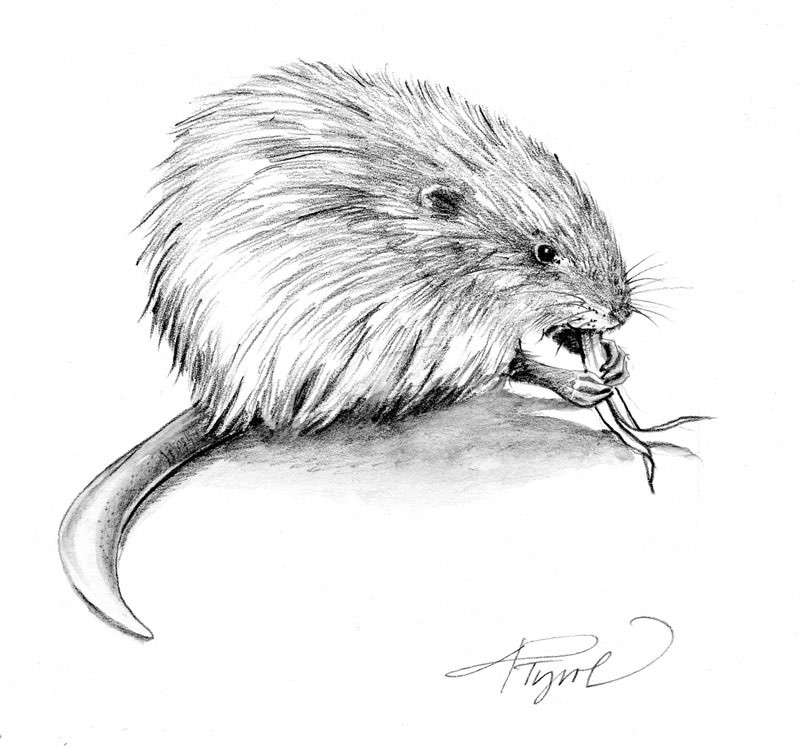
In early March, when many cold-weary souls head south for a late winter respite, others spend their days in toasty ice-fishing shacks on still-frozen ponds and on the bays of quiet rivers.
They have company: In the midst of some of these avid anglers are muskrats, who have their own winter retreats — dome-shaped mounds of marsh plants that cover holes in the ice. Inside these shelters the dark-brown rodents feed and rest during weather that would discourage the most hardened winter-sport enthusiasts.
Humans use gas-powered augers to drill holes in the ice; muskrats use their teeth. They gnaw four- to five-inch diameter holes and push marsh plants up through the ice to form their mound shacks. Then they chew out the interior to create a place to eat, rest and catch a breath of air after swimming under the ice.
But just as human anglers have regular homes, muskrats have their own year-around homes. In river ecosystems they often live in burrowed bank dens, but in marshes their more-permanent lodges are constructed of plants, such as cattails, and mud. These houses rest on a firm base—the marsh bottom. Muskrats build these lodges by piling up the plants, then chewing out an opening and carefully layering much of the removed material to the top of the rising mound. Inside each house, which is about one and one-half to three-feet high, a family of three to five muskrats snuggles to stay warm. If a lodge needs repairs, holes are patched with anything from water lily roots to frozen catfish pulled from the mud.
Muskrats spend lots of time in their winter homes and their shacks — eating food from their autumn caches plus other marsh plants foraged under the ice. They can dive for up to 15 minutes to gather plants because their heart rate decreases under water, and oxygen is drawn from stores in muscle tissue. Thick, waterproof fur keeps them dry and warm. Instead of being webbed like a beaver’s, the toes on their hind feet are fringed with stiff hairs, so they work like paddles. The muskrat’s long tail undulates to provide propulsion when the animal swims. The tail can be angled to act as a rudder.
Muskrats are in many ways well adapted to survive the winter. Diving muskrats can gather food without swallowing water because their lips seal shut behind the incisors. Nimble front paws manipulate the roots of cattails, water lilies, arrowheads, pondweeds and other marsh plants.
Muskrats are large for a rodent. Adults, weighing about two pounds and measuring roughly 20 inches from nose tip to the end of the 10-inch tail, make a tempting meal for various predators, such as minks, fox, weasels and marsh hawks. Underwater predators include large northern pike, pickerel and snapping turtles. To survive, muskrats are mostly active at night and during the hours of dawn and dusk. They aren’t strict vegetarians; they will eat fish, clams, crayfish, frogs and snails.
Winter can be treacherous. Paul Errington, the renowned hunter, trapper and wildlife biologist, recorded dramatic moments in muskrat lives in his landmark book, “Of Men and Marshes.” He mentions a morning encounter: “The whole top of the lodge shell is open, empty of muskrats, and powdered by the trace of snow. A mink-killed muskrat lies smeared with blood on the ice, and a drag trail represents another victim.”
So it can be bloody out there on the ice. Half of the muskrat population can die by mid-winter. Sometimes during cold snaps the openings to their push-up lodges freeze shut, closing off opportunities for oxygen and nourishment. As winter progresses, competition for food intensifies, forcing muskrats to venture out into the open, where they can succumb to cold or predation.
When spring finally arrives, the muskrat winter camps collapse during “ice-out.” But by then, the muskrats are traveling about on land, depositing a powerful scent along their routes to denote their territory. They also mate.
In early spring the adults kick the previous autumn’s youngsters out of the house. Then, in April or May, about a month after mating, a new litter is born. Around mid-summer, these little muskrats are driven away to make room for a second litter. And by the time the ice-fishing shacks appear again, adult muskrats, along with the late-summer crop of young, will be hunkered down in their own winter homes and shanties.


Discussion *